草学考试参考资料复习进程
草地学复习思考题
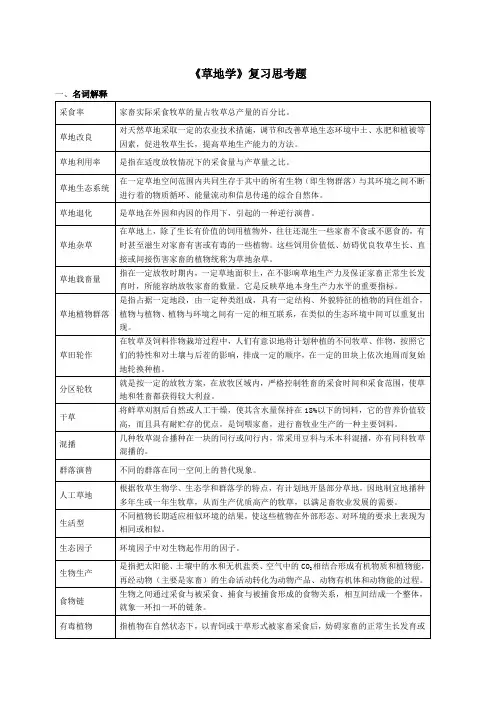
《草地学》复习思考题一、名词解释二、单项选择题三、简述题四、叙述题草场经营复习资料一、基本概念1.牧草:狭义:凡能够被家畜采食的一切草本植物广义:凡能够被家畜采食的一切草本植物、灌木、半灌木及部分的乔木的枝叶2.草地:是一种土地类型,是草本和木本饲用植物与所着生的土地构成的具有多种功能的自然综合体。
3.草业:以草原为基础,利用日光能合成牧草,然后利用一切可以利用的现代科学技术,通过生物,再通过化工、机械手段创造物质财富的产业。
4.草地畜牧业生产:在当地气候土壤等立地条件下,以植物性生产为手段,以动物性生产为目的的生产过程。
5.草地生产:在单位时间内单位面积上获得动物性产品的能力。
6.畜产品单位:1公斤酮体就是1个畜产品单位。
酮体(ketone body):在肝脏中,脂肪酸氧化分解的中间产物乙酰乙酸、β-羟基丁酸及丙酮,三者统称为酮体。
二、草地功能(一)草地生产功能:维持人类生存的食物、医药、工农业生产原料供给库之一。
(二)生态功能:1.水土保持(1)截留降水,保护土壤(2)分散、延缓、减弱径流,减轻土壤冲刷(3)提高土壤渗透,减少地面径流,防止土壤冲刷2.防风固沙3.改良土壤4.净化空气、维持碳氧平衡和调节气候(三)游憩功能三、世界草地的主要类型1、短草草地2、高草草原3、稀树草地4、荒漠5、栽培草地✓中国草地类型按照中国草地分类系统,我国草地划分18类:温性草甸草原;温性草原类;温性荒漠草原类;高寒草甸草原类;高寒草原类;高寒荒漠草原类;温性草原化荒漠类;温性荒漠类;高寒荒漠类;暖性草丛类;暖性灌草丛类;热性草丛类;热性灌草丛类;干热稀树灌草丛类;低地草类;山地草甸类;沼泽类;未划类草甸四、草场经营1.概念:农业科学的一个特殊分支,是以草地生态系统的基本规律为理论基础,来研究怎样合理利用草地,怎样改良草地,以提高其生产力,怎样适当利用饲草饲用家畜,在保持并提高草地生产力的原则下,能够获得高额的畜产品的理论与生产技术的一门综合性学科2.草场经营的目的:①保护和改善土壤和植被;②维持或增加草地畜产品的产量。
饲料学复习资料
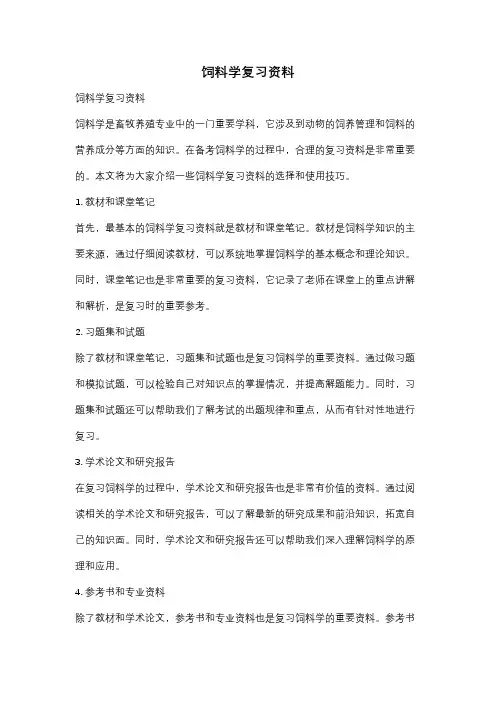
饲料学复习资料饲料学复习资料饲料学是畜牧养殖专业中的一门重要学科,它涉及到动物的饲养管理和饲料的营养成分等方面的知识。
在备考饲料学的过程中,合理的复习资料是非常重要的。
本文将为大家介绍一些饲料学复习资料的选择和使用技巧。
1. 教材和课堂笔记首先,最基本的饲料学复习资料就是教材和课堂笔记。
教材是饲料学知识的主要来源,通过仔细阅读教材,可以系统地掌握饲料学的基本概念和理论知识。
同时,课堂笔记也是非常重要的复习资料,它记录了老师在课堂上的重点讲解和解析,是复习时的重要参考。
2. 习题集和试题除了教材和课堂笔记,习题集和试题也是复习饲料学的重要资料。
通过做习题和模拟试题,可以检验自己对知识点的掌握情况,并提高解题能力。
同时,习题集和试题还可以帮助我们了解考试的出题规律和重点,从而有针对性地进行复习。
3. 学术论文和研究报告在复习饲料学的过程中,学术论文和研究报告也是非常有价值的资料。
通过阅读相关的学术论文和研究报告,可以了解最新的研究成果和前沿知识,拓宽自己的知识面。
同时,学术论文和研究报告还可以帮助我们深入理解饲料学的原理和应用。
4. 参考书和专业资料除了教材和学术论文,参考书和专业资料也是复习饲料学的重要资料。
参考书通常是由专家或学者编写的,它们对饲料学的知识点进行了更加详细和深入的阐述,可以帮助我们更好地理解和掌握知识。
专业资料则是关于饲料学的相关资料和信息,如饲料配方、饲养管理等方面的手册和指南,可以帮助我们了解饲料学的实际应用。
5. 网络资源和学术数据库如今,互联网已经成为获取信息的重要渠道之一。
在复习饲料学的过程中,我们可以利用网络资源和学术数据库来搜索和获取相关的资料。
然而,在使用网络资源时,我们要注意选择权威和可靠的网站和数据库,避免受到不准确或低质量资料的干扰。
综上所述,合理的复习资料对于备考饲料学非常重要。
除了教材和课堂笔记,我们还可以利用习题集、学术论文、参考书、专业资料以及网络资源和学术数据库等多种资料来进行复习。
牧草栽培学复习资料.docx
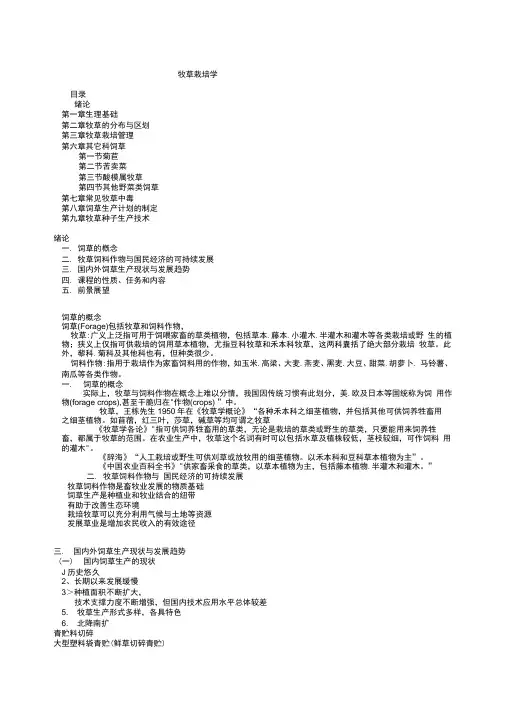
牧草栽培学目录绪论第一章生理基础第二章牧草的分布与区划第三章牧草栽培管理第六章其它科饲草第一节菊苣第二节苦卖菜第三节酸模属牧草第四节其他野菜类饲草第七章常见牧草中毒第八章饲草生产计划的制定第九章牧草种子生产技术绪论一.饲草的槪念二.牧草饲料作物与国民经济的可持续发展三.国内外饲草生产现状与发展趋势四.课程的性质、任务和内容五.前景展望饲草的概念饲草(Forage)包括牧草和饲料作物,牧草:广义上泛指可用于饲喂家畜的草类植物,包括草本.藤本.小灌木.半灌木和灌木等各类栽培或野生的植物;狭义上仅指可供栽培的饲用草本植物,尤指豆科牧草和禾本科牧草,这两科囊括了绝大部分栽培牧草。
此外,藜科.菊科及其他科也有,但种类很少。
饲料作物:指用于栽培作为家畜饲料用的作物,如玉米.高梁、大麦.燕麦、黑麦.大豆、甜菜.胡萝卜. 马铃薯、南瓜等各类作物。
一.饲草的概念实际上,牧草与饲料作物在概念上难以分情,我国因传统习惯有此划分,美.欧及日本等国统称为饲用作物(forage crops),甚至干脆归在"作物(crops) ”中。
牧草,王栋先生1950年在《牧草学概论》“各种禾本科之细茎植物,并包括其他可供饲养牲畜用之细茎植物。
如苜蓿,红三叶,莎草,碱草等均可谓之牧草《牧草学各论》"指可供饲养牲畜用的草类,无论是栽培的草类或野生的草类,只要能用来饲养牲畜,都属于牧草的范围。
在农业生产中,牧草这个名词有时可以包括水草及植株较低,茎枝较细,可作饲料用的灌木"。
《辞海》“人工栽培或野生可供刈草或放牧用的细茎植物。
以禾本科和豆科草本植物为主”。
《中国农业百科全书》"供家畜釆食的草类,以草本植物为主,包括藤本植物.半灌木和灌木。
”二.牧草饲料作物与国民经济的可持续发展牧草饲料作物是畜牧业发展的物质基础饲草生产是种植业和牧业结合的纽带有助于改善生态环境栽培牧草可以充分利用气候与土地等资源发展草业是增加农民收入的有效途径三.国内外饲草生产现状与发展趋势(一)国内饲草生产的现状J历史悠久2、长期以来发展缓慢3>种植面积不断扩大,技术支撑力度不断增强,但国内技术应用水平总体较差5. 牧草生产形式多样,各具特色6. 北降南扩青贮料切碎大型塑料袋青贮(鲜草切碎青贮)(-)国外饲草生产现状(三)发展趋势1. 现代集约化高效畜牧业的需求2. 发展草地畜牧业的需求3•退耕还草.生态建设的需求四.课程的性质.任务和内容牧草栽培学是研究牧草饲料作物的栽培技术.加工调制和经营组织的科学。
昆士兰现代草书学习手册说明书
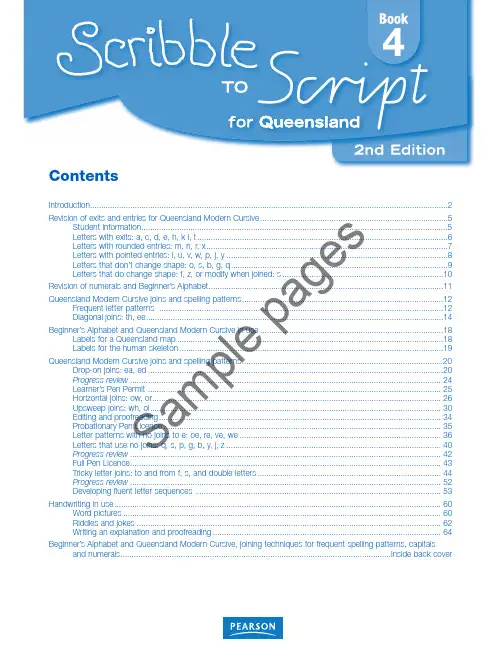
Introduction (2)IntroductionSince the introduction of Beginner’s Alphabet and Queensland Modern Cursive, ongoing syllabus and curriculum developments continue to guide classroom practice.Classroom teachers have identified issues and teaching strategies central to the effective teaching of handwriting.Scribble to Script for Queensland 2nd edition draws upon this information to help teachers to teach handwriting.Book 4 of the series is designed to assist students to become confident and proficient with the basic joining techniques of Queensland Modern Cursive. Activities encourage students to develop fluency of movement by practising both common and less frequent letter patterns as this provides opportunities to practise changing from one join to another within letter sequences and within words. As with previous books in the series, the teaching of handwriting is linked with the wider teaching of literacy,including spelling. Learning to write legitimate English letter sequences fluently and to increase writing speed without loss of legibility are central and connected goals, and hence a key focus in Book 4. This book continues to reinforce the need for consistency in letter size, shape, slope and spacing, while emphasising skills with joining techniques. Visual prompts provided at the top of some pages, along with slope lines,guide students to help them to develop the consistency in slope and spacing needed for independent writing.In particular, this workbook provides activities to:•promote continued development of letters that maintain uniform shape, size, slope and spacing in bothBeginner’s Alphabet and Queensland Modern Cursive •link correct joining techniques with spelling patterns used in high-frequency words, and other words commonly encountered at this year level•develop fluency and rhythmic movement by providing practice with fun writing patterns and activities •write fluently and legibly at speed•engage students in short, predictable handwriting exercises using a modelled, guided and independent approach to establish the fluency and correct letterformation needed for legibility in everyday cursive writingmodelledguided independent•reinforce a comfortable, appropriate posture and correct pencil and pen grip•encourage confident writing using 8 mm lined paper •introduce proofreading and editing skills.Beginner’s AlphabetBeginner’s Alphabet is used throughout primary school and beyond for a range of tasks such as labelling and mapping. Practice in using Beginner’s Alphabet serves a practical purpose, and provides opportunities to reinforce key principles underpinning the style that enhance fluency and legibility when joining.Capital LettersCapital letters in both Beginner’s Alphabet andQueensland Modern Cursive are unjoined. All capital letters start at the top, and most incorporate pencil lifts.They are written with the same slope as lower-case letters. Key Strategies for T eaching Queensland Modern CursiveIn Year 3, students were introduced to key ideas related to learning a cursive style of handwriting. For example, they were taught that joining strokes move from the exit stroke of one letter to the entry stroke of the next. Since several of the basic joins incorporate a pencil lift, they were also taught that this technique removes retrace movements between letters that often cause illegibility. Pen lifts also provide breaks in words, allowing the writing hand to move fluidly across the page.The six basic movements comprising the key skills of joined handwriting are:•diagonal joins •drop-on joins •horizontal joins •upsweep joins•letters that don’t join to e •letters that use no joins.Strategies for T eachingLegible and fluent cursive handwriting is dependent on correct letter formation and correct joining movements.Initially, this workbook emphasises learning to use the joining strokes required for cursive writing legibly and fluently.The importance of explicit teaching is oftenunderestimated in relation to the teaching of handwriting,particularly when it comes to joining skills, such as pen lifts, and executing less common letter patterns or complex letter sequences. Book 4 assists students to practise the movements required to produce fluent sequences of two, three or more letter groups, building their knowledge and skills with English spelling patterns.At this level, students need to produce greater amounts of writing. Most have developed the skills required for cursive handwriting, and are physically ready for the task ofdeveloping greater writing speed without loss of legibility.Verbal cueingVerbal cueing (talking through letter formation or a join)enables students to connect the perceptual-motor task with kinaesthetic (feeling) and verbal feedback when used with tracing, tracking within channels or copying.S a m p lep ag e sPhrases such as ‘begin at the top’, ‘move to the bottom’,‘push back to the left’, ‘move from the exit to the entry of the next letter’ and ‘reach, lift and drop on’ help todevelop verbal and visual memory. This helps students to develop awareness of spatial properties, enhancing development of automatic motor patterns for basic movements, letter formation, joining strokes and the writing of fluent letter sequences.High-frequency spelling patterns and wordsMany teachers build handwriting sessions around their spelling and wider literacy programs. This workbook links the teaching of handwriting with spelling by providing opportunities to explicitly practise common English letter patterns, and words containing these patterns. It provides activities designed to reinforce correct formation, frequent joining patterns, and the spelling of high-frequency words.Activities are designed to improve fluency, since students who write with speed and ease are more likely to enjoy writing and to develop positive attitudes towards spelling. Visual knowledge and spatial awareness of lettersStudents need support and practice in order to develop a visual and motor memory for the unique features and correct formation of letters, and for joining common letter patterns. Modelling and demonstration by the teacher (accompanied by verbal explanations) and timed practice by the student provide the basis for developing legible and fluent cursive handwriting at speed.Rhymes, prompts, guides, mnemonic devices, self-evaluation and self-correction techniques have been incorporated in this workbook to assist students to attend to critical attributes of letters, letter patterns and joining techniques.The following strategies support development of visual knowledge and spatial awareness of letter properties along with perceptual-motor aspects of letter formation and joining.•Highlight use of red and blue lines to reinforce spatial characteristics of letters and joins and placement of letters and sentences in cursive writing.•Discuss correct and incorrect models and visual prompts provided at the top of some pages, and encourage students to use slope lines as a guide to develop the consistency in slope and spacing needed for independent writing.•Students can imagine writing on a wide-screen TV or the screen of a computer or electronic game with a laser pen. Starting at the correct position, they imagine the index finger is a laser pen that can correctly join letters.Correct pencil gripTo ensure a clear view of their writing, right-handers should hold the pencil about 2–2.5 cm from the point and left-handers should hold it about 2–3 cm from the point. Some students need considerable ongoing support to develop awareness of the three fingers (thumb, index finger and middle finger) used in the dynamic tripod pencil grip.T eacher tips•To help correct and improve grip, engage in exercises such as wiggling and rolling the pencil barrel while using the correct grip and doing ‘caterpillar slides’,where the three fingers slide the barrel of the pencil from the writing point to the top of the pencil’s barrel and back again.•Use the ‘Ready, Set, Write!’ strategy for individual students experiencing pencil grip difficulties.Ready Grip the pencil between the thumb and first finger, with the writing point of the pencil pointing towards the web of the hand.Set Push the tip of the pencil with the middle fingernail and nail fold, until the pencil is partially rotated into the correct grip position.Write Practise pattern exercises to ‘feel’ the correct writing grip.• A small ball of paper held in the palm with the two resting fingers during short writing activities can help students who hold the pencil using more than the required fingers to ‘feel’ the correct grip. Reminders, praise, and teacher and parental guidance can help students with poor or immature pencil grip to develop an effective grip. Students require specific information about which fingers to use, where to place each finger and where the pencil should sit within the hand.PostureA comfortable and fairly upright writing posture should be encouraged at all times. Posture needs to be relaxed,well-balanced and upright when seated at a desk or table.It is important, however, to regularly relax an alert writing posture in order to avoid fatigue or tension in the neck or shoulders and in the writing arm, hand or fingers. Help students to develop the habit of regular, short breaks by incorporating a few moments of finger- and arm-stretching or relaxation exercises about every 20 minutes.Flat writing surfaces and a tendency for the upper body to follow the writing hand and arm as it moves away from the body make it difficult for the writer to clearly see what is written. This may lead to hooked wrists, twisted writing hands or non-standard posture. To help alleviate theseS a m p lep ag e sproblems, select books and writing paper of appropriate,manageable widths and encourage students to keep the writing hand in line with the arm and to lean the body slightly forward.Students can also be encouraged to develop comfortable and well-balanced working positions (such as standing,kneeling or lying on the floor) to suit writing tasks.Handwriting and New T echnologiesDespite the impact of information communicationtechnologies, it is important for students to learn a print script style followed by a cursive handwriting style, since most people will continue to rely on handwriting for many tasks. Pencils and pens are, in fact, simple forms oftechnology that are quiet, portable, easy to use and low-cost, making them accessible in most writing contexts.These tools, along with effective handwriting skills, will complement new technologies as further developments involving voice-activated and handwriting-recognition software, and smaller and tablet-based computers,become more widely available.As text-based communication in this information age becomes faster and more accessible, it often seems less personal; it is likely, therefore, that people will increasingly enjoy receiving handwritten letters, cards and notes. The knowledge and skills that underpin legible and fluent handwriting are central to effective communication via personalised stationery, calligraphy and other aspects of design.For many people, the kinaesthetics involved in handwriting is central to learning and to communication. There remains a clear need to teach all students to be skilful communicators who are able to use legible, fluenthandwriting along with new media to create, communicate and express ideas. It is important to engage students in writing for real audiences to help them see thathandwriting and computer technology complement one another as tools of expression.Assessment and EvaluationScribble to Script supports the successful modelled,guided and independent approach not only as a teaching and learning strategy, but also as a means for teachers to encourage students to see value in monitoring and improving their handwriting ability. Strategies such as those that follow and others provided on the Pearson Places website .au can help to encourage effective student self-assessment.•Provide supportive feedback by discussing with students the letters and joins they have formed well and those needing further practice. This provides a model, showing how they might assess and monitor their own progress.•Refer students to graphic prompts throughout the book as models to assist them to monitor aspects of their own handwriting performance; for example, on pages 23 and page 27 appropriate finger and pen pressure is modelled.•Provide letter patterns for students to copy as a guide for assessment of their own progress. Encourage them to circle or tick correctly formed letters or joins, and discuss their achievements with them.•Following handwriting sessions, encourage students to engage in independent self-assessment of progress. To help develop this skill, assist them to complete speed and legibility trials and assessment boxes, where provided.•Use the Learner’s Pen Permit, the Probationary Licence and the Full Pen Licence as incentives to motivate students to increasingly gain effective control of both pencils and pens.•Use revision lines and progress reviews to reinforce formation, shaping, size and slope of letters, and joining techniques.•The Year 4 checklist provided at the Pearson Places website .au can be used daily,weekly, fortnightly or each term or semester to indicate to students the level of focus required on key components of the Year 4 program. Use the illustrations and the star rating system to provide students with feedback about their level of skill attainment for each area of focus.S a m p lep ag e ssegapelpmaS:::segapelpmaSsegapelpmaSComplete the shadow puppet. Create your own.segapelpmaS。
草学考试参考资料复习进程

草学考试参考资料精品资料仅供学习与交流,如有侵权请联系网站删除 谢谢2一、草地放牧的优越性a.放牧是经济有效的家畜饲养方式 ,青草具有良好的营养价值,营养价值高 、 适口性好;b. 放牧促进家畜的健康;c. 放牧是草地管理的重要环节之一(适度放牧—正效应 // 放牧不足或过度放牧—负效应)二、放牧对草地的影响 (总结:放牧对草地的影响是一个十分复杂的问题 其影响的程度也受多种因素的制约,如放 牧强度、家畜分布、植物种类、利用季节、 放牧家畜的种类等) 家畜、土壤和植被之间是 一个有机联系的整体 (去叶 践踏 粪便排泄)— (植物 多样性 生长 繁殖 土壤 理化性质)—(草地 生产力) 反之,草地对家畜也产生影响:(1)牧草的数量和质量 (2)土壤中矿物质的含量 (3)寄生虫的发生1 放牧对牧草的影响:a.对牧草繁殖的影响 (种子繁殖、营养繁殖 有利方面—适度放牧刺激生长;不利方面—过度放牧影响繁殖)// b.放牧对草群成分的影响( 草群中高大草类将消失,同时为下繁草类的生长发育创造了有利条件。
借种子繁殖的草类数量会大大减少或完全消失。
适口性好的牧草数量减少或衰退而适口性差的牧草或家畜不吃的牧草数量增加。
草群中出现莲座状植物、根出叶植物及匍匐植物,不易被家畜采食,适应强度放牧的结果。
)// c. 放牧对土壤的影响(有利方面:畜蹄的践踏具有耙、压作用;不利方面: 改变土壤的物理性状 ;影响土壤水土保持的能力:地表径流、土壤水分蒸发)三、草地对放牧的响应不同草地类型、草地不同发育阶段和不同植物种类组成的草地对放牧的响应各不相同。
草地植物的补偿生长: 试验证明适当放牧可以提高草地植物生产能力。
McNaughton(1979,1983)提出放牧优化理论,认为食草动物和牧草的进化是同时进行的,适度放牧对草地植被是有益的。
放牧优化理论中草地植物对放牧的响应:第一种,植物对放牧特别敏感,家畜采食即使是轻牧, 都会造成植物伤害甚至死亡,属于欠补偿性生长(Under Compensatory Growth ); 第二种,植物开始对放牧没有响应或不受放牧影响,当放牧达到一定强度时才会受到伤害,属于等补偿性生长;第三种,植物在放牧作用下快速生长,当放牧强度达到一定水平,植物生长也会达到一个最优化水平,但如果放牧超过这一强度,植物的生长将减速直至死亡,属于超补偿性生长。
中药士复习计划
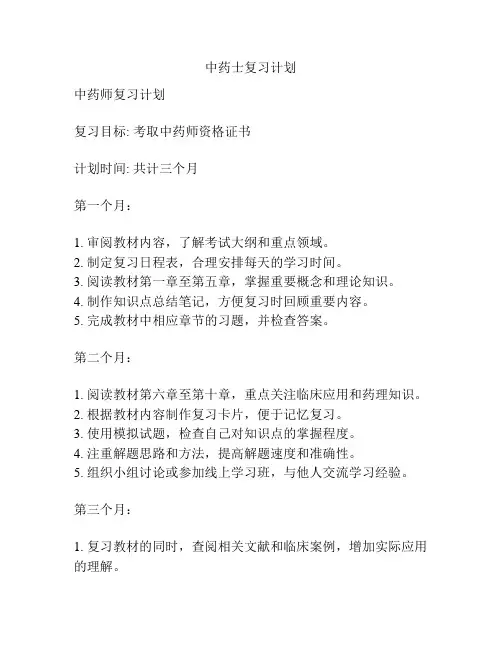
中药士复习计划
中药师复习计划
复习目标: 考取中药师资格证书
计划时间: 共计三个月
第一个月:
1. 审阅教材内容,了解考试大纲和重点领域。
2. 制定复习日程表,合理安排每天的学习时间。
3. 阅读教材第一章至第五章,掌握重要概念和理论知识。
4. 制作知识点总结笔记,方便复习时回顾重要内容。
5. 完成教材中相应章节的习题,并检查答案。
第二个月:
1. 阅读教材第六章至第十章,重点关注临床应用和药理知识。
2. 根据教材内容制作复习卡片,便于记忆复习。
3. 使用模拟试题,检查自己对知识点的掌握程度。
4. 注重解题思路和方法,提高解题速度和准确性。
5. 组织小组讨论或参加线上学习班,与他人交流学习经验。
第三个月:
1. 复习教材的同时,查阅相关文献和临床案例,增加实际应用的理解。
2. 着重复习重点章节和考试频率高的知识点。
3. 完成一套全真模拟试卷,熟悉考试形式和时间管理。
4. 找到自己的薄弱点,加强针对性复习。
5. 考前进行模拟演练,熟悉考场氛围,提高应试能力。
此复习计划旨在帮助中药师考生系统学习和复习中药学知识,并提高解题和应试能力。
根据个人情况和时间安排,可适当调整计划内容和时间分配。
最重要的是保持持续性的学习和复习,坚持下去,相信自己能够成功。
草地学考试复习资料
1.草地(Grassland)简单定义:草地是草及其着生的土地构成的综合自然体,土地是环境,草是构成草地的主体,也是人类经营利用的主要对象。
现代草地定义:草地是主要生长草本植物,或兼有灌丛或稀疏树木,可以为家畜或野生动物提供食物和生活场所,并可以为人类提供优良生活环境、其他生物产品等多种功能的土地——生物资源和草业生产基地。
三、草地学1.定义:研究从草地上获得高产、优质饲草进行畜牧业生产,而草地生产力和生态功能得以维持的科学。
2.内容:生物学基础、生态学基础、饲用价值、草地类型及分布规律、草地资源、草地利用、草地培育、人工草地的建植、牧草加工、草地经营等。
3.任务:研究和应用现代草业科学理论和技术,为草地畜牧业和草地农业的发展建立巩固的饲草料基地,提供充足的优质饲草料,提高草畜转化效率,生产满足人民需要的高质量的畜产品,并通过技术措施有效保护草地,为保护和改善人类生存环境服务。
草地主要植物及其特征根据草地植物的经济价值分为4种经济类群:禾本科草类豆科草类莎草科草类杂类草类(外部形态、生物学特征、经济价值)禾本科草类的经济价值(1)从营养的成分来说,富含无氮浸出物(NFE)(2)适口性好,大多数禾本科草无论放牧或调制干草,家畜都很喜欢吃;(3)在天然草地上的出现率和丰富度较高;(4)禾本科特别有价值的特性是调制干草或运输时叶子不易脱落,长期贮存产生的草末很少,也不易霉烂,是最好的调制干草的原料;(5)禾本科草有很强的耐牧性,再生力强。
因此,禾本科草的经济价值居首位。
豆科草类的经济价值(1)从营养的成分来说,蛋白质量高(18~24%),含钙丰富(>0.9%);(2)适口性好,家畜都很喜欢吃;(3)豆科草开花期长,营养成分下降没有禾本科迅速;(4)豆科草的根部具有根瘤,有固氮作用,能增加土壤中氮含量;(5)豆科草叶片干燥时容易脱落,调制干草时养分容易损失。
因此,豆科草的经济价值居第二位。
多年生草类的生长发育时期(物候期)1.萌发(返青期):鉴别萌发再生的标准是50%的植株返青为萌发返青期。
草学考试参考资料
一、草地放牧的优越性a.放牧是经济有效的家畜饲养方式,青草具有良好的营养价值,营养价值高、适口性好;b. 放牧促进家畜的健康;c. 放牧是草地管理的重要环节之一(适度放牧—正效应牧草繁殖的影响(种子繁殖、营养繁殖有利方面—适度放牧刺激生长;不利方面—过度放牧影响繁殖)牧对草群成分的影响( 草群中高大草类将消失,同时为下繁草类的生长发育创造了有利条件。
借种子繁殖的草类数量会大大减少或完全消失。
适口性好的牧草数量减少或衰退而适口性差的牧草或家畜不吃的牧草数量增加。
草群中出现莲座状植物、根出叶植物及匍匐植物,不易被家畜采食,适应强度放牧的结果。
)放牧对土壤的影响(有利方面:畜蹄的践踏具有耙、压作用;不利方面:改变土壤的物理性状;影响土壤水土保持的能力:地表径流、土壤水分蒸发)三、草地对放牧的响应不同草地类型、草地不同发育阶段和不同植物种类组成的草地对放牧的响应各不相同。
草地植物的补偿生长:试验证明适当放牧可以提高草地植物生产能力。
McNaughton(1979,1983)提出放牧优化理论,认为食草动物和牧草的进化是同时进行的,适度放牧对草地植被是有益的。
放牧优化理论中草地植物对放牧的响应:第一种,植物对放牧特别敏感,家畜采食即使是轻牧,都会造成植物伤害甚至死亡,属于欠补偿性生长(Under Compensatory Growth);第二种,植物开始对放牧没有响应或不受放牧影响,当放牧达到一定强度时才会受到伤害,属于等补偿性生长;第三种,植物在放牧作用下快速生长,当放牧强度达到一定水平,植物生长也会达到一个最优化水平,但如果放牧超过这一强度,植物的生长将减速直至死亡,属于超补偿性生长。
放牧对草地植物的影响:a.过度放牧(光合作用降低、碳水化合物储藏减少、根生长缓慢、种子产量降低、竞争力降低、草地覆盖物积累减少、水土流失);b.轻度或中度放牧( 光合作用增强、分蘖增加、遮阳减少、呼吸损失减少、促进植物生长因子活动、减少多余的地表覆盖物、刺激植物生长)四、放牧地的合理利用合理放牧:草地在正确的管理下能长期保持稳定的生产力、相对稳定的草地群落结构,土壤不出现沙化、盐碱化或水土流失,放牧家畜的各项生产指标(生长、泌乳、繁殖、产毛)处于良好状态。
草学概论复习题.docx
草学概论复习题—、概念1.草原(任继周)主要生长草本植物,或兼有灌木和稀疏树木,可为家畜和野生动物提供生存场所的大面积土地,是畜牧业的重要生产基地。
2.草业是“以草原为基础,利用日光能量合成牧草,然后用牧草通过兽畜、其他生物,再通过化工、机械手段,创造物质财富的产业”。
3.植物种同一种的个体I'可具有基本相同的形态结构;同一种具有相近的地理生态分布区域;种内的个体间能够进行有性生殖,并能生出正常可育的后代。
4.种群一个地区内同一种的个体总和5.群落共同生活在一起的多种植物构成的系统6.植被一个地区全部植物群落的总体7.优势种群落中多度和重量均占优者。
8.建群种优势种中的最优者。
盖度最大。
(重量最大),多度也大的优势种。
9.优势度是指植物在群落中所起的作用和所占地位的重要程度。
10.样方是能够代表样地信息特征的基本采样单元。
11.载畜量样地所在草地型每月、每年的放牧家畜折合绵羊单位的只数。
12.产草量草地牧草产量是指单位面积的草地在一定的时期内可以为家畜提供可食牧草的数量,也称为牧草的经济产量。
13.盖度指样方内各种植物投影覆盖地表面积的百分数。
14.株丛数指样方内各个植物种的植株或株丛的数量。
15.频度是植物种在群落中分布均匀程度的数量指标,指某种植物在草场上出现的次数。
16.侵蚀模数每年每平方公里土壤流失吨数;17.青干草是指适时刈割经过自然或人工干燥后的绿色干草。
18.草地培育以草地生态系统理论为指导,合理利用和改良天然草地、建立人工和半人工草地,以及对草地进行经营和管理的过程。
19.演替草地上一种植物群落被另一植物群落所替代的变化发展过程,叫做演替。
20.进展演替演替的结果为牧草繁茂,层次和种类组成复杂、品质好,产草量高,土壤日渐肥沃而有利于生产的演替21.退化演替演替结果为劣草增多,牧草品质差,产草量低,环境旱化,土壤愈来愈瘠薄, 结生产带来不利的影响而不利于生产的演替。
22.乔木有明显的主干,高度在5m以上。
2019年北京林业大学林学院草学(090900)研究方向、考试科目、参考书目、复习指导
2019年北京林业大学林学院草学(090900)研究方向、考试科目、参考书目、复习指导一.研究方向01草坪科学与管理02高尔夫球场及运动场建设与管理03草地植物栽培与育种04草地资源与生态二.初试考试科目①101思想政治理论②201英语一③721植物生理学与生物化学④805草坪学或801草地生态学三.复试笔试科目专业综合考试(包括草坪学、草坪有害生物防治、草地学、草地生态学)四.参考书目1.初试参考书目721植物生理学与生物化学【1】植物生理学,第三版,郑彩霞主编,中国林业出版社,2013【2】现代植物生理学,第三版,李合生主编,高等教育出版社,2012【3】普通生物化学,第三版,郑集陈均辉编著,高等教育出版社,2003805草坪学【1】《草坪学》(第四版),孙吉雄、韩烈保主编,中国农业出版社,2015年4月出版801草地生态学【1】《草地生态学》,周寿荣主编,农业出版社,1996【2】《生态学》,李博主编,高等教育出版社,1999【3】《草地农业生态学》,任继周主编,中国农业出版社,19952.复试参考书目全面考查考生的草业科学专业素养和创新能力,对草业科学研究领域的理解等,无指定参考书目五、北林机械工程复习备考建议1、零基础复习阶段(6月前)本阶段根据考研科目,选择适当的参考教材,有目的地把教材过一遍,全面熟悉教材,适当扩展知识面,熟悉专业课各科的经典教材。
这个期间非常痛苦,要尽量避免钻牛角尖,遇到实在不容易理解的内容,先跳过去,要把握全局。
系统掌握本专业理论知识。
对各门课程有个系统性的了解,弄清每本书的章节分布情况,内在逻辑结构,重点章节所在等,但不要求记住,最终基本达到北林本科水平。
2、基础复习阶段(6-8月)本阶段要求考生熟读教材,攻克重难点,全面掌握每本教材的知识点,结合真题找出重点内容进行总结,并有相配套的专业课知识点笔记,进行深入复习,加强知识点的前后联系,建立整体框架结构,分清重难点,对重难点基本掌握。
- 1、下载文档前请自行甄别文档内容的完整性,平台不提供额外的编辑、内容补充、找答案等附加服务。
- 2、"仅部分预览"的文档,不可在线预览部分如存在完整性等问题,可反馈申请退款(可完整预览的文档不适用该条件!)。
- 3、如文档侵犯您的权益,请联系客服反馈,我们会尽快为您处理(人工客服工作时间:9:00-18:30)。
草学考试参考资料
精品资料
仅供学习与交流,如有侵权请联系网站删除 谢谢2
一、草地放牧的优越性
a.放牧是经济有效的家畜饲养方式 ,青草具有良好的营养价值,营养价值高 、 适口性好;
b. 放牧促进家畜的健康;
c. 放牧是草地管理的重要环节之一(适度放牧—正效应 // 放牧不足或过度放牧—负效应)
二、放牧对草地的影响 (总结:放牧对草地的影响是一个十分复杂的问题 其影响的程度也受多种因素的制约,如放 牧强度、家畜分布、植物种类、利用季节、 放牧家畜的种类等) 家畜、土壤和植被之间是 一个有机联系的整体 (去叶 践踏 粪便排泄)— (植物 多样性 生长 繁殖 土壤 理化性质)—(草地 生产力) 反之,草地对家畜也产生影响:(1)牧草的数量和质量 (2)土壤中矿物质的含量 (3)寄生虫的发生
1 放牧对牧草的影响:a.对牧草繁殖的影响 (种子繁殖、营养繁殖 有利方面—适度放牧刺激生长;不利方面—过度放牧影响繁殖)// b.放牧对草群成分的影响( 草群中高大草类将消失,同时为下繁草类的生长发育创造了有利条件。
借种子繁殖的草类数量会大大减少或完全消失。
适口性好的牧草数量减少或衰退而适口性差的牧草或家畜不吃的牧草数量增加。
草群中出现莲座状植物、根出叶植物及匍匐植物,不易被家畜采食,适应强度放牧的结果。
)// c. 放牧对土壤的影响(有利方面:畜蹄的践踏具有耙、压作用;不利方面: 改变土壤的物理性状 ;影响土壤水土保持的能力:地表径流、土壤水分蒸发)
三、草地对放牧的响应
不同草地类型、草地不同发育阶段和不同植
物种类组成的草地对放牧的响应各不相同。
草地植物的补偿生长: 试验证明适当放牧可以提高草地植物生产能力。
McNaughton
(1979,1983)提出放牧优化理论,认为食草动物和牧草的进化是同时进行的,适度放牧对草地植被是有益的。
放牧优化理论中草地植物对放牧的响应:第一种,植物对放牧特别敏感,家畜采食即使是轻牧, 都会造成植物伤害甚至死亡,属于欠补偿性生长(Under Compensatory Growth ); 第二种,植物开始对放牧没有响应或不受放牧影响,当放牧达到一定强度时才会受到伤害,属于等补偿性生长;第三种,植物在放牧作用下快速生长,当放牧强度达到一定水平,植物生长也会达到一个最优化水平,但如果放牧超过这一强度,植物的生长将减速直至死亡,属于超补偿性生长。
放牧对草地植物的影响:a.过度放牧(光合作用降低、碳水化合物储藏减少、根生长缓慢、种子产量降低、竞争力降低、草地覆盖物积累减少、水土流失);b. 轻度或中度放牧( 光合作用增强、分蘖增加、遮阳减少、呼吸损失减少、促进植物生长因子活动、减少多余的地表覆盖物、刺激植物生长)
四、放牧地的合理利用
合理放牧:草地在正确的管理下能长期保持稳定的生产力、相对稳定的草地群落结构,土壤不出现沙化、盐碱化或水土流失,放牧家畜的各项生产指标(生长、泌乳、 繁殖、产毛)处于良好状态。
(一)放牧的适宜时间(牧草返青后的15~18天是牧草发育的临界期,放牧上称为忌牧期;适宜于开始放牧的时期:牧草返青生长15~18天以后 ;放牧过早、过迟都不利,最迟不易晚于禾草拔节期)// 适宜于结束放牧的时期:停止生长前1个月保证地上营养物质向根系转移、 储藏,有利于明年牧草再生。
(二)草地利用率与采食率 a.草地利用率是指在适度放牧情况下的采食量与产草量之比。
草地利用率(%)=适当采食量/某地段
总产草量 (在适宜利用条件下,草地的表现是既不放牧过重也不放牧过轻,牧草正常生长,并能维持家畜的正常生产生活。
) 确定草地利用率时
应考虑的因素:(1)草地的耐牧性(2)地形与水土保持情况(3)牧草质量状况(4)是否干旱(5)人工草地或天然草地(6)牧草的临界期。
b.采食率=家畜实际采食牧草的量占牧草总产量的百分比。
采食量测定方法:(1)双样方法(2)Cr 2O 3 (3)食道瘘管法 (4)链烷法
(三)草地的放牧强度 确定了利用率,就能根据采食率来检查放牧场的利用是否符合规定的利用程度。
放牧强度:放牧草地表现出来的放牧轻重程度(采食率≈利用率 放牧适宜;采食率<利用率轻度放牧;采食率>利用率过度放牧) (四)草地载畜量 在一定放牧时期内,在一定草地面积上,在不影响草地生产力及保证家畜正常生长发育时,所能容纳放牧家畜的数量。
它是反映草地本身生产力水平的重要指标。
决定载畜量的三要素:家畜数量、放牧时间、草地面积。
(a.时间单位法:头日/hm 2 在单位面积的草地上,一定数量的家畜能放牧的日数。
b,面积单位法:hm 2/羊单位.年 在一定时期内,单位数量家畜所需草地的面积。
C.家畜单位法:羊单位.年/hm 2 在一定面积的草地上,一年内能放养成年家畜的头数。
) 我国“绵羊单位”:在单位利用时间内、单位面积上所能承载饲养的标准家畜头数。
羊单位:1只体重50kg 并哺半岁以内单羔,日消耗1.8kg 标准干草的成年母绵羊,或与此相当的其他家畜为一个标准羊单位。
(标准干草:达到最高月产量时,收割的以禾本科牧草为主的温性草原或山地草甸之含水量14%的干草。
) 草地载畜量的确定方法:(经验估计、根据家畜的健康状况来估计、用放牧实验法估测、按草地产草量估算)
载畜量=饲草量(kg /hm 2)×利用率/[家畜日食量(kg/日•头)×放牧天数]
载畜率=饲草量(kg /hm 2)×采食率/[家畜日食量(kg/日•头)×放牧天数] (载畜率:在一定放牧时期内,一定面积的草地上实际放牧家畜的数量)
分区轮放 :按一定的放牧方案,在放牧地内,严格控制牲畜的采食时间和采食范围,使草地和牲畜都获得较大利益。
分区轮牧的优点:(1)减少牧草浪费,节约草地面积;(2)改进植被成分,提高牧草的产量和品质,轮牧均匀利用草地,防止杂草滋生,优良牧草较多,自由放牧摧残优良牧草植被成分变坏;(3)增加畜产品,轮牧避免家畜活动过多消耗热能,均匀利用草地,家畜健康生长发育;(4)加强放牧地的管理,利于有计划采取相应的农业技术措施;(5)防止家畜寄生蠕虫病的传播,轮牧经安排不在同一草地连续放牧6天以上,减少感染幼虫的机会。
划区轮牧 定义:根据草地生产力和家畜数量,将草地划分为若干面积相等的分区,规定每个分区的放牧日期,然后按计划分区顺序放牧,并在放牧日程上规定轮牧周期和放牧次数。
第八章 牧草的生产与加工
割草地:指牧区草原、农区草山草坡、沿海滩涂草地以及人工、半人工草地中能够进行割制干草的生产地段,它是草地的一个重要组成部分。
割草地的选择(根据草地类型、自然条件和干草产量高低等,选择以禾本科草为主、植株较高和具有一定产量的草地作为割草地。
)
牧草的刈割时期(影响割草地单位面积产量和干草品质):当年干草产量和干草营养物质含量。
根据生长期内割草地产量动态和牧草营养物质积累动态规律,确定在单位面积营养物质总收获量最高时期进行刈割。
开花期刈割可收获较高产草量和营养物质含量。
(个别情况下草地最高产量是在结实期)开花后延迟刈割,会降低干草品质。
综合考虑当年的割草地产量和干草的营养物质含量,尤其是可消化营养物质含量,牧草的适宜刈割时期应当以开花期为最好。
刈割时期对下年草地产量的影响 科学实验证明:下一年草地最高产量是在本年开花期刈割情况下获得;相反地,下一年草地的最低产量却是在本年早期(开花初期以前)刈割情况下获得。
牧草的饲用价值:确定刈割时期不一定完全按照草群中主要植物的生物学特性。
(高大杂类草草地:抽穗(现蕾)初期到开花期刈;高大禾本科草地:抽穗初期刈;芦苇割草地应在抽穗之前上有8~9片叶时;蒿类草地,在结实期刈,以减少苦味;针茅为主草地,在芒针形成或出现前刈割)刈割高度: 影响干草数量和品质的重要因素(a.牧草刈后留茬越高 收获量越低,草地产量的损失也越大;影响干草营养物质含量/ b.刈后留茬过低 ,降低了牧草的光合作用,影响刈后再生和地下器官营养物质的积累;适宜的牧草刈割高度为5~6cm, 但对下繁草草地为3~4cm, 地面不平时,可提高高度。
)。
